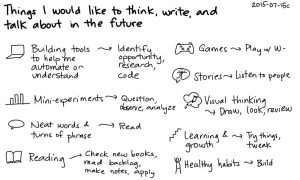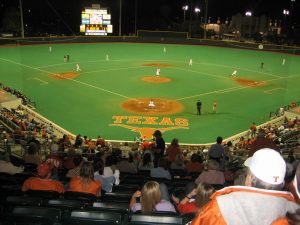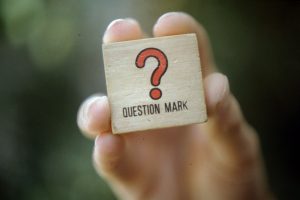How can technology be integrated into a course such as physical education when the two components seem to be at odds with one another? Technology may be seen as a sit down and absorb information activity. In comparison physical and health education appears to display learning through various movements. How does an educator bridge the divide? The article Pedagogical uses of Technology in Physical Education by Susana Juniu (2011) suggests that the preconceived notion of the separation derives from an educators lack of knowledge about how to effectively use technology. I resonate with this because when I first started teaching, technology seemed like a black hole of information. If I was unable to navigate it then how could I possibly teach it to my students? It was something that was better left alone than engaged with in case something went wrong. Yet, Instructional Planning Activity Types as Vehicles for
Curriculum-Based TPACK Development by Judi Harris & Mark Hofer (2009), outlines an important piece of the puzzle in that “instructors should choose the appropriate educational technology after identifying the learning goals and developing the learning activities, rather than planning the instruction around them (p.3)”. In reading this, I realized that technology is not meant to take the place of the teacher. Instead, it is a tool that can be used to display students learning in comparison to the traditional model. If teachers can have an understanding of a few technological tools, in collaboration with their comprehension of learning goals, then technology becomes a vehicle of learning.

Juniu’s, 2011, article focuses on teaching physical educators how to implement technology effectively into their classes. It seeks to have preservice teachers use the project-based learning framework to explore technological implementation. The study outlines how the projects are meant to emulate real-life situations in which they could apply various technological tools within their teaching. Essentially, the idea was to have the educators apply theoretical knowledge and put it into a practical situation. The findings are that when navigating project-based learning, also known as PBL, the “instructional approach not only allows the students to gain technological skills through a collaborative activity but helps them apply this experience to the “problem” of how to find the best balance of technology and pedagogy in their teaching” (Juniu, p. 48). The idea of balance can be explored in the chapter Action Research in Education Getting to Grips with Perspectives and Models in the book Action Research in Education by Mary McAteer, 2013. I am reminded of this article due to the fact that it is the responsibility of the educator to reflect in a purposeful manner. Balance to me means incorporating new ways of learning into previous teaching philosophies. Thus, in order to integrate technology and PBL into physical and health education, the educator would need to understand the content from various points of view. When seeking further understanding educators could use the practice of action research where the purpose is to “[enable] professionals to understand their practice better, and use that enhanced understanding in order to effect changes in practice” (McAteer, p. 3).

The possibility of PBL, technology and physical and health education being successfully integrated together is an idea that excites me. I have always been a competitive person, mostly due to my participation in sports such as softball and dance. This competitive drive was something I took pride in all throughout my education and it is what pushes me to seek different ways of teaching. One problem that I continued to face as both a student and educator is the idea of curriculum subjects being separate from one another. I could not find avenues, or did not understand how to find avenues that interrelated my passions. How can we as educators teach curriculum in a cyclical model that does not exclude subjects but embraces cross-curricular concepts when elementary school teachers are taught as generalists versus specialists? Juniu, 2011, states that “[e]ducators are models to students, and to be models of innovation they need to experience educational innovation in their own preparation” (p. 48). In going through my teacher education program, we were allotted two weeks of physical education training. I only graduated from that program only three years ago, so why is so little importance put on physical and health education training when it can be an intimidating subject for teachers? Juniu recognized that physical education can provide a difficult circumstance in that it is not taught in the everyday classroom but an entirely different space such as the gymnasium or outside. Thus, physical education is a curricular area not known by many, unless enthusiastically explored previously, and taught within a variety of spaces. This idea alone presents challenges to teachers, then with the addition of technology, it’s no wonder there might be a perceived divide.

In thinking about this concept of integrating PBL into physical and health education I am reminded of the article Why Minimal Guidance During Instruction Does Not Work: An Analysis of the Failure of Constructivist, Discovery, Problem-Based, Experiential, and Inquiry-Based Teaching by Paul A. Kirschner, John Sweller and Richard E. Clark, (2006), where they speak to idea that when we introduce problem-based learning it cannot be a fully hands off approach from the teachers role. Instead, scaffolding should be given where students work with previously learned knowledge. PBL, in physical and health education, might develop the way teachers effectively teach and assess this subject. For example, when teaching about the concepts of game play it is important to consider the rules and the objective of the game. This area might be further explored through PBL by having students create their own game consisting of rules from popular sports such as football or baseball. Thus, the educator allows for the individuals understanding versus the traditional fitness testing. Furthermore, when using technology and PBL within physical and health education could the use of social media be an advantage? An example may be them videoing themselves dancing or explaining a part of a game that they are learning or have created. This might allow for a deeper and possibly more meaningful connection to concepts explored in this subject. However, it is the the educators due diligence to ensure safety, transparency and to ensure that policy guidelines are being met by their employer.

What if we took the lens that Juniu (2011) provides, that we need to teach the married approach of “practical knowledge of technology tools with a pedagogical understanding of how technology can support problem solving and enhance collaborative learning” (p. 45). Will there be further engagement in physical and health education from each individual within the class? Could there become a deepened understanding of play based sport and the technical aspects of psychical and health education? In embracing this model we might see that there is a shift in student perspective where they no longer view success to be determined by only athletic experience and physical development. Instead, students might may develop the understanding and appreciation for the critical life skills that are being taught. What would be the learning and cross curricular opportunities if PBL became apart of how we teach this subject? If all educators started to take the perspective that physical and health education is an vital aspect of student learning, could the increase in importance of physical and health education throughout a population be affected? When considering how technology can shift our view of teaching Raj Dhingra at TedX provides an interesting stance.
What can be the effects of changing our view of teaching?
Picture Reference List In order:
“PICT0018” by BAMCorp is licensed under CC BY-SA 2.0
“montana-4” by rxb is licensed under CC BY-SA 2.0
“Track Separation” by mikecogh is licensed under CC BY-SA 2.0
“longhorn baseball” by Sherri Barras is licensed under CC BY 2.0

Leave a Reply